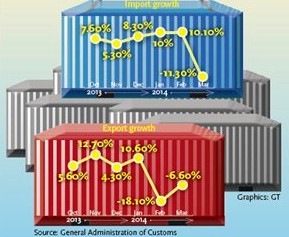

China's overall trade is expected to report stable growth this year, with the weak data in the first quarter mainly resulting from high base effects, the Ministry of Commerce (MOC) said in a post on its website on Monday.
China's total trade volume unexpectedly declined 1 percent year-on-year to $965.9 billion in the first three months, which added to concerns that China's economy could slow further.
But MOC explained that the drop was mainly due to distorted trade figures in the first quarter of 2013, which had been inflated by fake export invoices used to disguise money flows.
Excluding the base effects, trade growth in the first quarter was within a stable range and was better than the performance of other major economies, MOC said, adding that China's trade situation is expected to improve after May as trade figures returned to normal after a crackdown on fake invoices in May last year.
Though many uncertainties are still weighing on China's foreign trade, such as rising labor costs and appreciation of the yuan, steady growth of the Chinese economy and recovery in the global economy will allow for stable trade growth, the ministry said.
In the first quarter, total trade volume with the US, Europe and Japan reached $334 billion, up 6.4 percent year-on-year. Trade volume with these three accounted for 34.6 percent of China's overall trade volume, compared with 32.2 percent in the same period of 2013, MOC data showed.
"If there are no big fluctuations in the external environment, China's imports and exports are likely to maintain relatively stable growth in 2014," the ministry said.
"China could report trade growth of 7.5 percent to 8 percent this year… given that the overall global economy is showing signs of warming up," Xu Hongcai, director of the Department of Information at the China Center for International Economic Exchanges, told the Global Times on Monday.
But He Weiwen, co-director of the China-US-EU Study Center under the China Association of International Trade, noted that it would be a tough task to reach trade growth of 7.5 percent as Chinese goods still have relatively low added-value and lack competitiveness. Also, developed economies are trying to boost their own manufacturing industries.
In a post on Sunday, MOC said the decision in March by the People's Bank of China, the central bank, to double the daily yuan trading band against the US dollar to 2 percent would add to uncertainties over the profits of exporters.
Data from MOC showed that China's total trade in goods reached $4.16 trillion in 2013, up 7.6 percent year-on-year, overtaking the US for the first time to become the largest goods trading country.
In a separate press conference in Beijing on Monday, MOC spokesman Yao Jian said that trade in services would become a strong boost for China's overall trade in the future.
In the first quarter, total services trade reached $138.8 billion, up 15.6 percent year-on-year, accounting for around 12.8 percent of the country's total trade volume, up from 11.5 percent for the whole of 2013.
The trade deficit in services rose to $118.5 billion in 2013, but Xu noted that the deficit could help to maintain the balance of China's international payments. Also, introducing advanced services to China can benefit the domestic manufacturing industry.
"The growth rate of services trade will continue to outperform [that of] goods trade in the future… and the deficit in services trade will also remain for a period as China still lags behind developed economies in the sector," He noted.
Forecast for foreign trade appears grim
2014-05-05Chinese gov‘t vows to support foreign trade
2014-05-01Weak trade figures ‘signal slowing economy‘
2014-04-11Further fall in trade seen in March
2014-04-11China‘s March trade worse than expected
2014-04-11Copyright ©1999-2018
Chinanews.com. All rights reserved.
Reproduction in whole or in part without permission is prohibited.